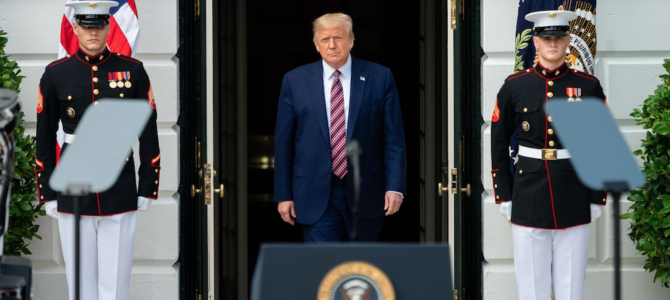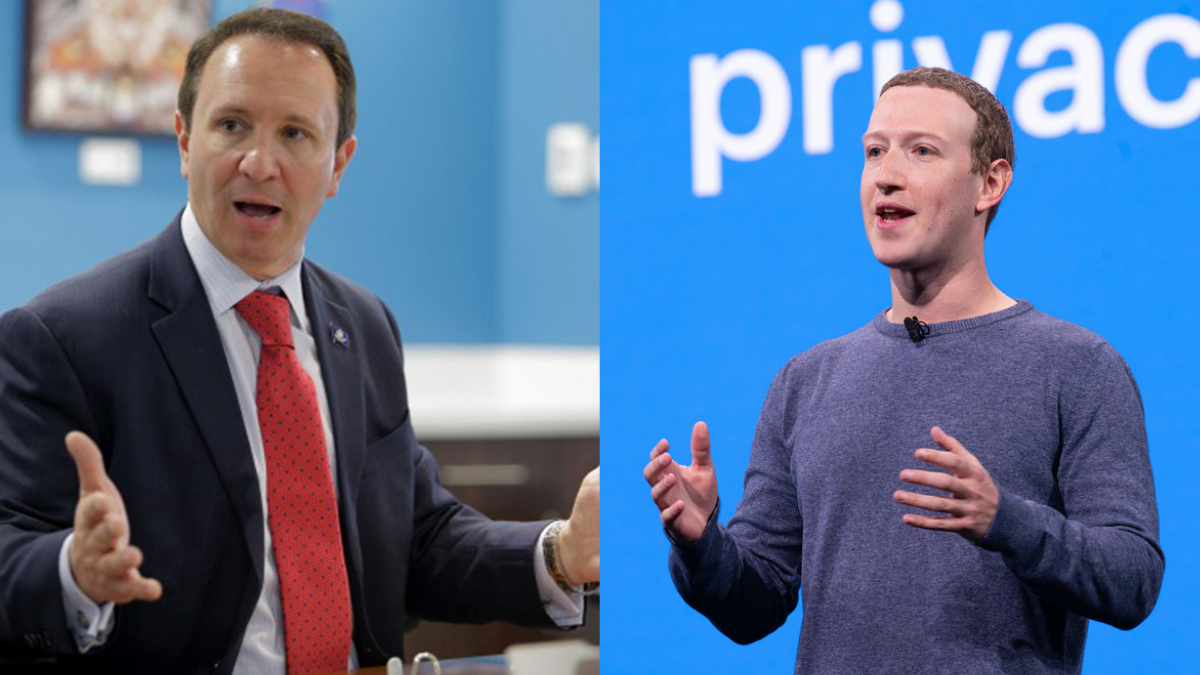
The coronavirus pandemic and recession that followed make it hard for any other news to make it to the front page, but the end of the tragedy is in sight. Just this week, researchers at Oxford announced positive results in human trials for their vaccine. Even if we are not yet at the beginning of the end, we may be, as Winston Churchill once said, at the end of the beginning.
That means it might be time, at last, for the presidential campaign to focus on more than the pandemic. By this point in the election cycle, we should be hearing about the two candidates’ visions for the next four years.
Looking at President Trump’s statements and actions over the past few years, one can discern a pattern. Overall, it comes down to the idea of protecting American freedom in all its forms. Emphasizing these five themes of protection could summarize for voters what they would get from four more years of Trump in the White House.
1. Protecting American Jobs
If there is one way in which Trump departed from Republican orthodoxy in 2016, it was on trade protection. Maintaining this message is paramount. The importance of jobs and the meaning of work used to be recognized across party lines in America.
Increasingly, however, voices on the left are discarding the universal virtue of industriousness and advocating instead for a managed decline in which vast swaths of the populace are considered unemployable. Many moderates in both parties would respond to a message of getting more people off welfare and into jobs.
How could Trump sharpen this message for voters? Managed trade has been his signature issue and his most consistent belief since the 1980s. Trump has been free in using temporary tariffs to gain concessions from communist China, but that and even the United States-Mexico-Canada Agreement are just tinkering at the edges of free trade. He should declare the rules of the game have changed and work with Congress to erect tariff barriers on unfree economies such as China.
China outcompetes us on price because it uses state power to suppress wages, break unions, ignore environmental regulations, and operate state-owned businesses at a loss. Tariffs on China’s goods would not ban these products; it would merely put them on an equal footing with goods made in a free country. Beyond that, Trump and Congress should ban the import of goods produced with the slave labor of Uyghur prisoners, which we now know is increasingly common in China.
Many in Trump’s own party will call this an industrial policy, and they will be right. But our steadfast refusal to make such a policy does not mean we don’t have one. It means we have China’s industrial policy, imposed on us without our consent.
Replace that with a policy that favors American jobs and trade with countries that operate honestly, and Trump will have achieved the biggest part of his 2016 agenda. Many 2020 voters will appreciate that and understand the contrast with Joe Biden’s willful blindness on communist China.
2. Protecting the Border
Another signature 2016 campaign issue was Trump’s promise to enforce immigration laws. He has largely followed through on this policy, although mishandling of minors caught illegally immigrating significant damaged the administration. Arranging more humane detention centers and speeding up the judicial process for asylum claims could resolve that problem while keeping the promise of law enforcement.
All the Democrats had to do was be normal — promise to fix the detention centers and enforce the law efficiently. Instead, Biden and his party have campaigned on a decriminalization of illegal immigration, promising they would treat the crime of illegal entry into the United States as a minor civil offense, essentially no worse than jaywalking. Set against that, all Trump must do to appeal to an electoral majority is promise the vigorous enforcement of existing laws, a mainstream position.
Protecting the border ties in with protecting American jobs. Labor is not exactly like any other commodity, but the laws of supply and demand do affect it. A government that declines to enforce the law allows the labor supply to grow, with some of those laborers working under the table for less. That drives wages down and makes it harder for people who play within the rules, including both the native-born and those who immigrated here legally, to earn a living. Simply enforcing the law makes this a winning issue for Trump in 2020.
3. Protecting Family Life
Widespread lawlessness, attacks on our national symbols, and the economic consequences of the pandemic have all thrown American families for a loop. As institutions decay or actively turn against traditional family life, it becomes more difficult to hold a family together.
It is hard for the government to stand against the societal changes that caused many of these harms, but there are ways it can help. Trump has offered his support for the Cassidy-Sinema bill, a bipartisan proposal for a tax credit that would fund paid maternity leave.
The bill proposed by Sens. Joni Ernst, R-Iowa, and Mike Lee, R-Utah, is an even better solution, but both are budget-neutral ways to help young families when they need it most. Our economy has changed to one in which two working parents is the norm, but Trump and these lawmakers recognize that economic concerns cannot always dictate family life.
Another burden on young families is the lack of schooling in the wake of the Wuhan virus pandemic. School districts across the nation are deciding what to do in September, with many declining to open full-time or even part-time. For parents, this creates an impossible situation in which they must educate children while working full-time and managing the household. People with au pairs and private tutors will get by, but the rest are sinking fast — especially those whose jobs are impossible to do from home.
Trump should continue to encourage schools to open safely. Universal public education once made up the nation’s premier formative institution. Now, public schools can barely keep their doors open. A six-hour Zoom call is no substitute for the classroom.
Federal powers in this area are limited (and should be), but Trump should continue to promote open schools and school choice. Let education dollars follow the child, not the school, and parents will be better able to provide education for their kids and begin to restore normalcy to that crucial part of American life.
4. Protecting Life
Another issue that brought voters to Trump’s side in 2016 was his promise to protect the right to life while his opponent was campaigning for the right to abortion on demand at any stage of a pregnancy. The country remains divided on the issue, but Democrats have gotten more radical, something that should hardly have been possible.
Biden’s flip-flop on the Hyde Amendment would have American taxpayers funding infanticide. Democrats have been explicit: Pro-life voters have no place in their party.
In the face of this barbarism, Trump has proved to be a steadfast, if unlikely ally. He is a late convert to the cause, and many pro-life conservatives doubted his commitment to the important issue in 2016. But whether out of political convenience or a true change of heart, the president has trumpeted the cause of life, even attending the March for Life this year, something no other president has ever done.
Any Republican president who falls short on this point would lose a considerable portion of his base. Trump has lived up to his promises in this area. To turn out the voters he needs to win in 2020, he must remind them of this point and contrast it with the increasing pro-abortion tilt of the Democrats.
5. Protecting the Constitution and the Rule of Law
Nearly every day, Biden or one of his campaign surrogates promises to do some disservice to the Constitution. They want to abolish the Electoral College, amend the First Amendment, ignore the Second Amendment, and impose blatantly unconstitutional taxes. This is nothing new. The courts and the Constitution were an important issue in 2016 too, and many Republicans who were otherwise skeptical of Trump voted for him to ensure one of the judges on his list would be appointed to the Supreme Court.
Even conservatives who disagree with Trump’s positions in other areas must admit he has been true to his word on judicial appointments. By naming capable, intelligent, originalist judges to the bench, Trump fulfilled the promise of 2016 and ensured a conservative legacy will outlive him. Emphasizing this in 2020 is essential to retain those same voters.
Trump should also challenge Biden to publish his own list of potential Supreme Court nominees. Let the voters see and compare the constitutional visions of the two candidates and determine for themselves which one is more likely to protect our Constitution and the rule of law.
The theme of the law will also draw a needed distinction between the two candidates. Lawlessness and riots in some of America’s cities show how a few radical criminals can make life intolerable for the masses. Peaceful protests should always be permitted, but violent rioting must end.
Where the riots involve federal crimes, this must include federal law enforcement. Trump cannot force mayors and governors to follow their laws, but where rioters attack federal officials or property, arrests in accordance with the rule of law must follow.
Sending the Right Message
All of this combines to make a coherent platform for a 21st-century Republican Party, and all of it aligns with things Trump has already done or said. Weaving it all together will help the campaign cut through the gaffe-a-day reporting that takes over election season and pushes substantive issues to the side.
But that requires message discipline from the campaign — and the president. Tweets send the message to the people over the heads of media interlocutors, but random, off-topic tweets are counterproductive and give the scandal-mongers what they want.
Carried out correctly, these five points of emphasis will present the American voters a real choice between two contending schools of thought, which is, after all, what elections are supposed to be.









